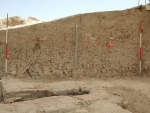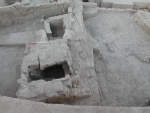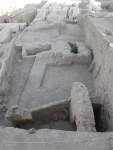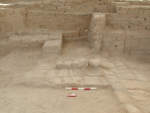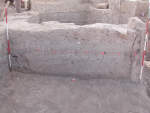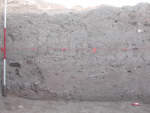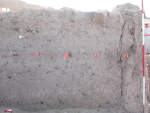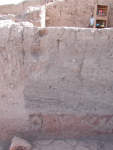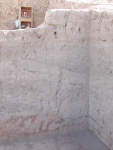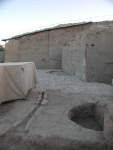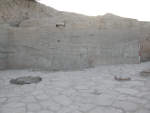1. OVERVIEW
| Roster | Date | Author | Record |
|---|---|---|---|
| Category | !! | !! | installation |
| Best definition | 2001-06-10 | !! | structure [Input: L724LR.j] |
| Summary | 2007-07-16 | sG | One room structure in locus k6. This is the earliest of the structures in k6 and belongs to phase 5b. [Input: R716SG.j] |
| Best image | 2007-07-16 | sG | 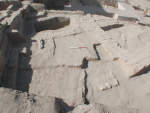 v58 [Input: R716SG.j] |
2. IDENTIFICATION
Designation
| Roster | Date | Author | Record |
|---|---|---|---|
| Definition | 2001-06-10 | lR | structure [Input: L724LR.j] |
| Description (summary) | 2001-06-10 | lR | one room structure [Input: L724LR.j] |
3. STRATIGRAPHY
Recovery/Assignment
| Roster | Date | Author | Record |
|---|---|---|---|
| Daily notes about recovery of elements | 2001-07-04 | fAB | k6 contains a2, which we have not touched this season, since it was dug by A13 in MZ12, and is the oldest structure in A16. [Input: L704FAB.j] |
| Notes on recovery | 2001-06-17 | fAB | When cleaning this square, gB and the newer members of the staff discovered a floor (f29) that was associated with the rest of a2. [Input: L617FAB.j] |
| 2001-06-26 | fAB | I explored today the area above and between a1 and a2. It is odd that the alignment is so similar, but it is clear from what I saw that they are two distinct structures, even in two distinct strata. [Input: L630TR.j] |
Volumetric Localization
| Roster | Date | Author | Record |
|---|---|---|---|
| Locus | 2001-06-10 | lR | k6 [Input: L724LR.j] |
| Relays (applicable to elements) | 2001-06-12 | lr | r15 (41186 37385 - 8809 / Relay location: see sketch 8) [Input: R7QFAB1R.j] |
| 2001-06-12 | lr | r16 (41164 37702 - 8801 / Relay location: see sketch 8) [Input: R7QFAB1R.j] | |
| 2001-06-12 | lr | r17 (41153 37523 - 8809 / Relay location: see sketch 8) [Input: R7QFAB1R.j] | |
| 2001-06-12 | lr | r18 (41184 37516 - 8809 / Relay location: see sketch 8) [Input: R7QFAB1R.j] | |
| 2001-06-12 | lr | r19 (41237 37646 - 8809 / Relay location: see sketch 8) [Input: R7QFAB1R.j] | |
| 2001-06-12 | lr | r20 (41250 37406 - 8809 / Relay location: see sketch 8) [Input: R7QFAB1R.j] | |
| 2001-06-12 | lr | r21 (41034 37714 - 8812 / Relay location: see sketch 8) [Input: R7QFAB1R.j] | |
| 2001-06-12 | lr | r22 (40927 37544 - 8811 / Relay location: see sketch 8) [Input: R7QFAB1R.j] | |
| 2001-06-12 | lr | r28 (40940 37413 - 8804 / Relay location: see sketch 8) [Input: R7QFAB1R.j] | |
| 2001-06-12 | lr | r29 (40947 37413 - 8804 / Relay location: see sketch 8) [Input: R7QFAB1R.j] | |
| 2001-06-12 | lr | r30 (40947 37353 - 8804 / Relay location: see sketch 8) [Input: R7QFAB1R.j] | |
| 2001-06-12 | lr | r31 (40939 37349 - 8804 / Relay location: see sketch 8) [Input: R7QFAB1R.j] |
Spatial Aggregation
| Roster | Date | Author | Record |
|---|---|---|---|
| Features within aggregate | 2000-12-18 | !! | f8 (wall) f9 (wall) f10 (wall) f22 (accumulation A) f29 (floor, type a) [Input: A-CUMUL.j] |
| Items within aggregate | 2000-12-18 | !! | i22 (bowl) [Input: A-CUMUL.j] |
| q-lots within aggregate | 2000-12-18 | !! | q18 q23 q198 (items, pottery) q518 [Input: A-CUMUL.j] |
Time Sequencing
| Roster | Date | Author | Record |
|---|---|---|---|
| Stratum (to which element belongs) | 2000-12-18 | !! | s255AHH [Input: A-CUMUL.j] |
| 2015-05-20 | !! | s250AAH s255AAH [Input: ZA520CJC.j] |
|
| Phase (to which element belongs) | 2000-12-18 | !! | h6hAAH [Input: A-CUMUL.j] |
| 2015-05-20 | !! | h6hAAH [Input: ZA520CJC.j] | |
| Notes on time sequencing | 2001-06-17 | fAB | This aggregate is covered by brickfall f25 (which is actually in k5, but clearly is present in k6) which instead abuts a1 in k5. This means that a2 is earlier in date than a1, and a3 to the E seems to also be abutted (or even the point of origin) by a brickfall f21 which seems the same as f25. [Input: L617FAB.j] |
| 2001-07-04 | fAB | We are presented now with the problem of linking the several aggregates together into a meaningful stratigraphic sequence. As we understand it now, a2 is the oldest structure that we have, as it sits on the pit in the N section of A13. a2 is clearly below a1, separated by a gray layer. a1 is contemporary with a5 and a3, since all abut but are not covered by brickfall. Questions arise when we look at the differences in elevation: a5 is considerably higher than a1 and a3. This seems to indicate a terracing, which we would expect to result from extended building in the phase of a2. [Input: L704FAB.j] | |
| 2001-07-23 | sV | a2 belongs to phase 5b and seems to be the only well preserved structure of this phase. The other structures to the West of a2 show a more complicated situation. [Input: L818LR.j] |
6. REFERENCE
Analogical Record
| Roster | Date | Author | Record |
|---|---|---|---|
| Photo of context (v view) | |||
| View/drawing of aggregate | |||
